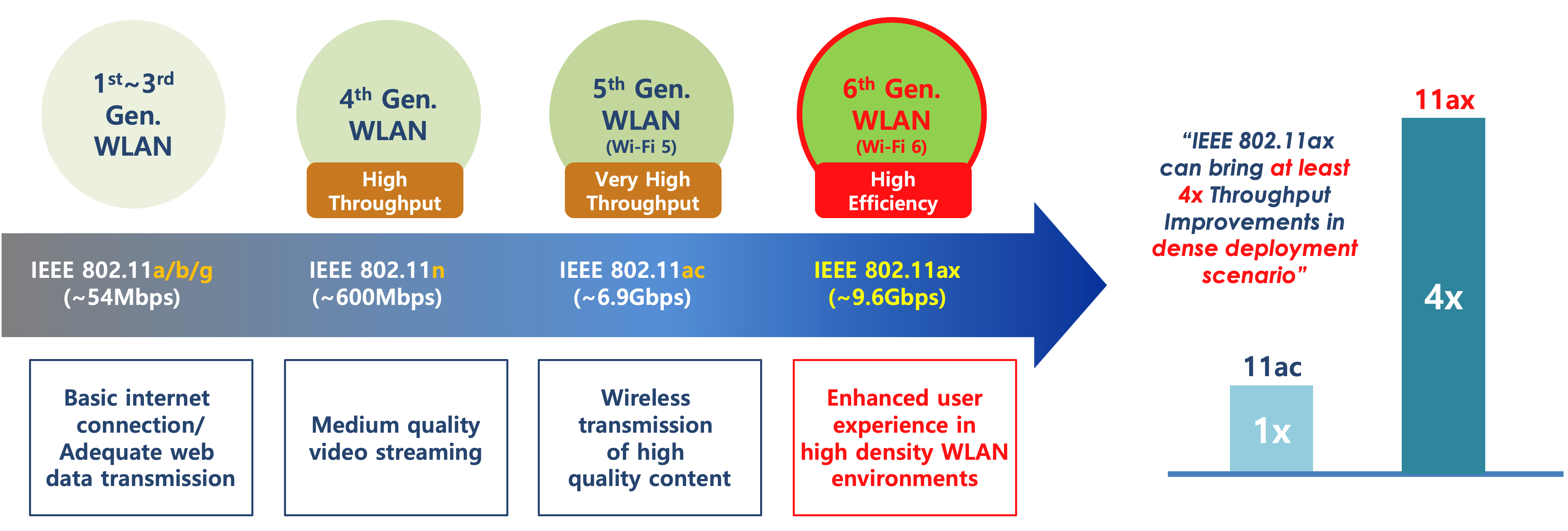Backgrounder: About WILUS Inc.
Overview
This document briefly describes WILUS, Wi-Fi 6, and WILUS’ contribution to the 802.11ax specification, or labeled Wi-Fi 6 by the Wi-Fi Alliance. Though a relatively small company, WILUS contributed to many critical features in Wi-Fi 6, and its patent portfolio represents a significant component of Wi-Fi 6-related IP.
About WILUS
WILUS is an R&D Company based in South Korea, which was founded in 2012 by Jin Sam Kwak (1) to focus on wireless and multimedia technologies for next generation ICT standards such as LTE-Advanced Pro, 5G NR(-Advanced), Wi-Fi 6, MPEG-H 3D Audio, and VVC. Within WILUS, more than 30 engineers and experts hold advanced degrees (Ph.D./M.S.) and have unparalleled expertise and experience in wireless connectivity and all relevant standards technologies. During the past ten years, WILUS’ standards team has been a key contributor to global ICT standards development for the next generation of wireless and multimedia services.
About Wi-Fi 6
The IEEE 802.11ax standard, otherwise known as Wi-Fi 6, or High-Efficiency WLAN (HEW) is the latest technology replacing the current 802.11ac WLAN devices, providing scalability and uncompromised performance. The high-level goal for Wi-Fi 6 was to improve spectrum efficiency and throughput in high-density Wi-Fi environments. As formulated, Wi-Fi 6 lets access points support more clients in dense environments and provides a better experience for typical wireless LAN networks. Wi-Fi 6 also provides up to 4x increase in throughput while reducing power consumption reduced by up to 66%. Figure 1 shows the evolution of Wi-Fi standards.
Figure 1. The Evolution of Wi-Fi Standards
WILUS Contributions to 802.11ax/Wi-Fi 6
Some background on the IEEE and its standard-setting process will be helpful to understand WILUS’ contribution to Wi-Fi 6. Briefly, the 802.11ax standard is an IEEE specification, Wi-Fi 6 the Wi-Fi Alliance designation. The IEEE (I-triple-E) is the Institute of Electrical and Electronics Engineers, a professional and standard-setting organization. The IEEE 802.11 working group under the IEEE Project 802 LAN/MAN Standards Committee (aka IEEE 802 or LMSC) sets all Wi-Fi standards.
The standardization process starts with a functional requirements document that, as the name suggests, defines the technical requirements for the new specification. Once defined, individual members in dozens or hundreds of companies submit technical contributions to meet these requirements. This is a competitive process as different companies propose different technologies and technological approaches.
Movement through the process is driven by individual voters in the IEEE 802.11 working group. Specifically, at various points in the standard-setting process, at least 75% of voters must agree to add a technical contribution to the specification framework, adopt the specification into a draft, and approve the draft. Though WILUS is small compared to many contributors in global big companies, WILUS had several voting members in the IEEE 802.11 working group and actively participated in IEEE 802.11ax standards development with their technical expertise. During the Wi-Fi 6 development process, WILUS submitted more than 90 contributions with almost 30 adopted contributions from May 2014 to the publication of the specification in May 2021. This placed WILUS well within the top 20 contributors to Wi-Fi 6 – if we were to limit the analysis to the contributions submitted before November 2016, when Draft 1.0 was released (2), WILUS would rank even higher.
As it is standard practice, WILUS secured the ideas aimed to 802.11ax by patenting them and then strategically submitted selected ideas as the technical contributions, based on the standards progress for the development of IEEE 802.11ax specification. All patents including the technical proposals to the 802.11ax totaled more than 500 patents by the end of 2021, and the total is expected to grow to more than 750 granted patents by the end of 2025.
In terms of coverage within the main features of Wi-Fi 6, the WILUS patent portfolio addresses, together with others, about 90% of the more than 40 (new) core features of Wi-Fi 6 and contributes to the primary benefits of Wi-Fi 6 (faster throughput, higher capacity) as well as other benefits (extended wireless range, longer battery life, and coexistence with legacy Wi-Fi devices). The main features and relevant benefits which WILUS contributed to are as follows:
PPDU format & Preamble
- defining new wi-fi frame structure for co-existence with legacy device and extended wireless range
Downlink OFDMA
- an access point transmits multiple data to multiple stations simultaneously, leading to faster aggregated network throughput
Uplink OFDMA (Trigger frame based)
- allows multiple stations simultaneously transmit data frames, greatly increases network capacity by removing contention overhead
Spatial Reuse & BSS Color
- more aggressive in accessing the medium with coloring mechanism for better network capacity in congested area
Target Wake Time & Power Save
- scheduling of traffic exchanges between an access point and a station to reduce power consumption
Summary
The formulation of a standard is a competitive, consensus-driven process that ensures that only the most innovative and best-performing technologies become part of the standard. WILUS was a substantial contributor to Wi-Fi 6 specification as measured by the number of accepted contributions and their importance to critical Wi-Fi 6 features. WILUS’s patent portfolio represents a critical component of the patents related to Wi-Fi 6.
(1) He received his B.S., M.S., and Ph.D. degrees in Electrical Engineering and Computer Science from Seoul National University, Seoul, Korea, in 1998, 2000, and 2004, respectively. After postdoctoral research positions at Georgia Tech. and UT Austin, from 2007 to 2012, he served as a chief research engineer at LG Electronics. During this time, he carried out research tasks focused on the IMT-Advanced and led the standards activities for wireless communications such as 3GPP, IEEE 802, Wi-Fi Alliance, and WiMAX Forum, as well as served as an alternative board member in Wi-Fi Alliance.
(2) Draft 1.0 is the most statistically significant, because it defines most of the basic features that constitute the core of the 802.11ax specification: this is when new chips started to be designed.

